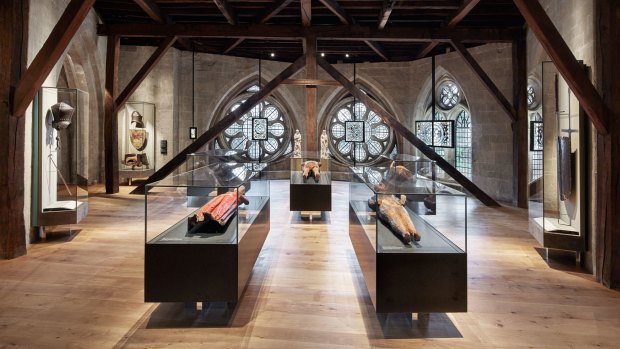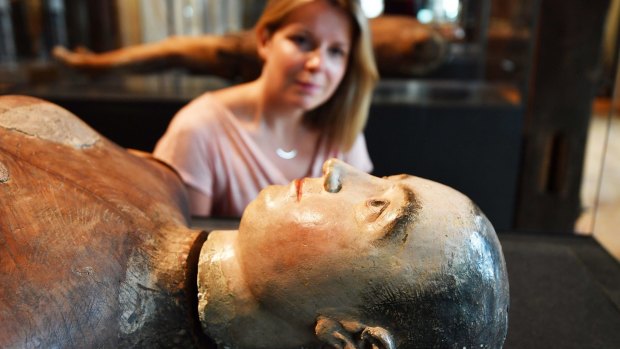This was published 4 years ago
London: The Queen's Diamond Jubilee Galleries' most interesting exhibits
By Tim Richards

The Queen's Diamond Jubilee Galleries.
It's remarkable to be standing so close to a historic wooden effigy of Queen Mary I. Crafted after her death in 1558, it was carved and painted to closely resemble her, and displayed on top of her coffin.
The detailed, coloured face is surprisingly lifelike, an intriguing glimpse across the gulf of time at Henry VIII's daughter. Intriguing but also a bit creepy, like a life-sized doll about to spring to life. It's surrounded by several other royal effigies including that of King Edward III, its plaster face supposedly based on his death mask.
To my mind, these funeral effigies are the most interesting exhibits in the Queen's Diamond Jubilee Galleries, high above the floor of Westminster Abbey within its 13th century triforium. Built to hold chapels which were never completed, this horseshoe-shaped space became a glorified attic. Now it's a new museum of fascinating items from the Abbey's collection.

The Funeral effigy of Queen Mary I.Credit: Getty Images
The funeral effigies are in the section devoted to the Abbey's connection with the British royal family. As a sign notes: "Coronations, weddings and funerals have been held here since the burial of King Edward the Confessor in 1066."
With that deep history to draw on, there's a wealth of items on show. In the first section, reached by stairs or lift, visitors walk by big Gothic windows and enormous diagonal support beams to examine objects connected with the Abbey's construction. There's a serene vibe up here, a welcome respite from the tourist crowds 16 metres below.
The exhibits are a delightfully eclectic jumble. Near the entrance, for example, is a pair of highly decorated wooden obelisks. Above them is a marble statue of 18th century Rear Admiral Richard Tyrell, above a chunk of sculpted coral. Nearby is a marvellous scale model of the Abbey which was commissioned by star architect Sir Christopher Wren when he wanted to add a spire (though the model took six months to make, the spire was never built).
Inside a case is the Abbey's original medieval timber altarpiece, decorated with glass, precious metals, and remnants of Biblical scenes. It's old, but not as old as the next amazing exhibit: a stone sarcophagus which was discovered next to the Abbey in 1869. In the 4th century it had been used to bury a Roman, then 600 years later reused for a Saxon. The skeleton within has been there for a millennium.
Behind it are pieces of 13th century stained glass, positioned to catch the light and display scenes from the lives of saints. I'm charmed by the lion and dragon buttresses on the walls above: the dragon has a particularly curious expression, as if half ravenous and half dopey.
Throughout the space are screens displaying explanatory information, including an animated sequence about structural changes over the centuries. In the section regarding worship and daily life, a star item is the Litlyngton Missal, an illuminated 14th century prayer book open to a page which is an attractive blaze of colour.
A final section deals with the Abbey's broader role as a repository of national memory. We all know about the creative geniuses remembered downstairs in Poets' Corner – my own favourite author PG Wodehouse recently had a memorial stone installed in the vicinity – but effigies of other famous Brits once stood on the Abbey floor. Finding a new home up here in the galleries are wax likenesses of such worthies as Admiral Horatio Nelson and Prime Minister William Pitt.
There are also lavish memorials to people I've never heard of, such as the 17th century Catherine Sheffield, Duchess of Buckingham (the illegitimate daughter of King James II, according to the Abbey's records). She couldn't force succeeding generations to remember her – but she still has a claim to fame here, in the engaging attic of a nation.
TRIP NOTES
FLY
Qantas flies to London via Singapore, see qantas.com
STAY
The Pilgrm has rooms in stylishly updated premises next to Paddington Station, from £119 ($A220) a night (see thepilgrm.com) while the Mandarin Oriental Hyde Park offers luxurious accommodation from £630 a night (see mandarinoriental.com/London).
TOUR
Entry to the Queen's Diamond Jubilee Galleries is an additional £5 on top of the Abbey's standard fee of £23 (cheaper online). See westminster-abbey.org
Sign up for the Traveller Deals newsletter
Get exclusive travel deals delivered straight to your inbox. Sign up now.